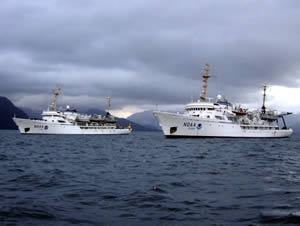
 |
|
|
August 23, 2009 'Hydropalooza' Provides Deeper Understanding of Alaska's Kachemak BayFrom a NOAA press release:NOAA ships and scientists have returned to Alaska's Kachemak Bay to kick off year two of Hydropalooza - a NOAA-led project to develop the most detailed seafloor and coastline maps ever generated of the area. 
Kachemak Bay, one of south central Alaska's most productive and ecologically diverse estuaries, supports maritime commerce, ferry transportation, fishing, and recreational boating from the nearby harbors of Homer and Seldovia. Up-to-date NOAA nautical charts, as well as sea bottom, water level, and shoreline information, are needed to ensure safe navigation, manage coastal resources, and support local planning. "The mapping data that NOAA collects will be used by state and local officials to make better informed decisions related to the coast, its habitats and its people," said James Hornaday, mayor of Homer. "I welcome our NOAA friends back to Kachemak Bay." Crews on board NOAA ships Fairweather and Rainier will conduct hydrographic surveys of the seafloor, measuring depths and identifying obstructions. When the ships complete data collection in early September, they will have surveyed more than 350 square nautical miles - an area nearly twice the size of Chicago. "This is one of our largest survey efforts of the year," said Capt. Steven Barnum, director of NOAA's Office of Coast Survey and U.S. national hydrographer. "The data we collect will contribute to navigation safety in the state and also be used to keep the coast healthy and productive." The vessels will also install new tide stations and high-precision global positioning system (GPS) base stations, which will record water levels and location information in real time. With Kachemak Bay's 28-foot tidal range from low to high tide - the fourth largest in North America - these data are needed to ensure the best quality surveys are conducted. Scientists from the NOAA Kasitsna Bay Laboratory, Kachemak Bay National Estuarine Research Reserve, Alaska Department of Fish and Game, University of Alaska Fairbanks and other NOAA offices are collaborating on how to use Hydropalooza mapping data to improve assessment and management of coastal resources. NOAA and Alaska Department of Environmental Conservation scientists are also conducting sediment sampling to assess pollutant levels and biodiversity on the seafloor. NOAA and the University of Alaska-Fairbanks will also use this detailed mapping data to provide an opportunity for college students to train in how to better sustain marine ecosystems in the Arctic and subarctic. The collection of shoreline and seafloor mapping data for a range of uses is the primary objective behind the federal multi-agency Integrated Ocean and Coastal Mapping initiative. The program allows NOAA and its partners to maximize the benefits of the data collected. "Our data are used by countless federal, state, and local stakeholders," said Captain Roger Parsons, NOAA Corps (ret.), IOCM director. "Coastline and seafloor data, once collected solely for updating NOAA's national suite of nautical charts, is now used for marine spatial planning efforts, ocean circulation monitoring, and assessing the impacts of climate change, among other uses." Data collected during Hydropalooza will be made free to the public online at: http://hydropalooza.noaa.gov. © AlaskaReport.com All Rights Reserved. |
|